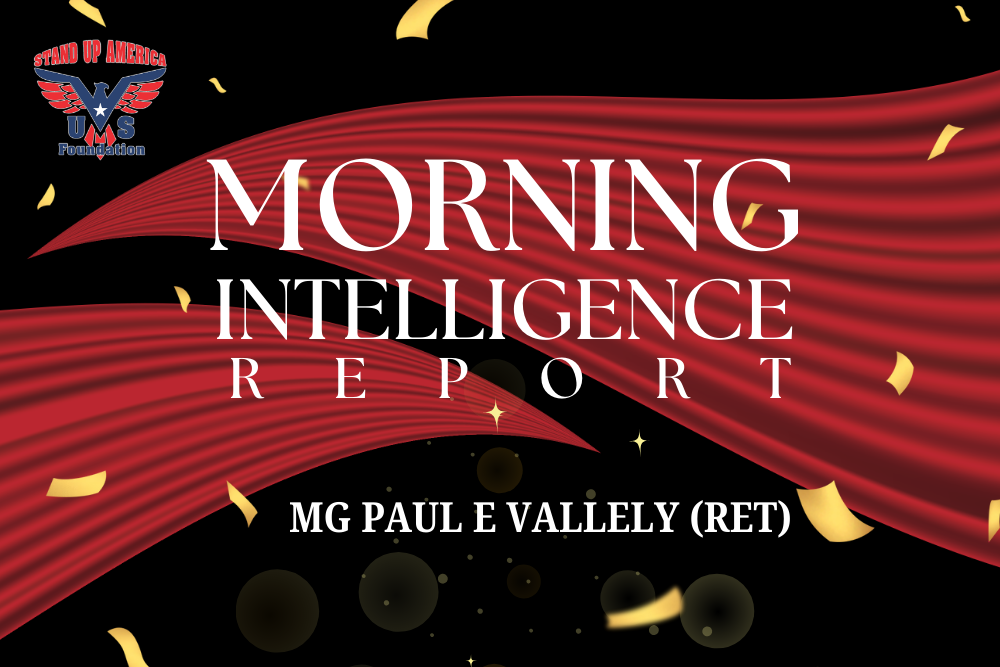By MG Paul E Vallely (ret)

It is finally time in 2025 for a new awakening to move away from past ideologies and partisan party politics to a world of facts, cognitive solution processes, and reality. President Trump is the only global leader employing this problem-solving method, which involves identifying a problem and then developing a plan to address it. This is what I call analyzing “reality” (the facts) and issues, and devising specific solutions.
We have at hand technology/AI that will enable Americans to build a new, modern system for selecting leaders at the local, state, and federal levels, as well as Members of Congress. These leaders will not function in making decisions based on partisan politics, but in problem-solving. This will require an in-depth study and analysis group to prepare this new path. The Stand Up America US Foundation, along with other firms, is prepared to establish a funded group to explore new creative paths and frontiers in leadership, problem-solving, and initiative and issue resolution.
In political science, a political ideology is a specific set of ethical ideals, principles, doctrines, myths, or symbols associated with a social movement, institution, class, or large group that explains how society should function and offers a political and cultural blueprint for a particular social order. A political ideology largely concerns itself with how to allocate power and to what ends it should be used. Some political parties adhere closely to a specific ideology, while others draw broad inspiration from a group of related ideologies without embracing any one of them in particular.
An ideology’s popularity is partly due to the influence of moral and financial entrepreneurs, who often act in their own interests rather than the interests of the people. Political ideologies have two dimensions:
Ideology is a collection of ideas that have evolved over the ages to dominate cultures, traditions, and societies, often to their detriment, and are manipulated for greater power and control over populations. Typically, each ideology contains certain ideas about what it considers the best form of government (e.g., autocracy or democracy) and the most effective economic system (e.g., capitalism, communism, and socialism). The same word is sometimes used to identify both an ideology and one of its main ideas.
For instance, socialism may refer to an economic system, or it may refer to an ideology that supports that economic system. The same term may also refer to multiple ideologies, which is why political scientists try to find consensus definitions for these terms.
For example, while the terms have been conflated at times, communism has come to refer in common parlance and academia to Soviet-type regimes and Marxist–Leninist ideologies, whereas socialism has come to refer to a broader range of differing ideologies that are most often distinct from Marxism–Leninism. Political ideology is a term fraught with problems, having been described as “the most elusive concept in the whole of social science.”
While ideologies tend to identify themselves by their position on the political spectrum (such as the left, the center or the right), they can be distinguished from political strategies (e.g. populism as it is commonly defined) and from single issues around which a party may be built (e.g. civil libertarianism and support or opposition to European integration), although either of these may or may not be central to a particular ideology. Several studies show that political ideology is heritable within families.
The following list is strictly alphabetical and attempts to categorize the ideologies found in practical political life into several groups, with each group comprising ideologies that are related to one another. The headers refer to the names of the most well-known ideologies within each group.
The names of the headers do not necessarily imply a hierarchical order or that one ideology evolved from the other. Instead, they are merely noting that the ideologies in question are practically, historically, and ideologically related to each other.
As such, one ideology can belong to several groups, and there is sometimes considerable overlap between related ideologies. The meaning of a political label can also differ between countries, and political parties often subscribe to a combination of ideologies.
Reality and truth are closely intertwined concepts, yet they have distinct characteristics. Reality refers to the state of things as they exist, encompassing all aspects of the physical world and the experiences within it. It is objective and independent of human perception or interpretation. On the other hand, truth relates to the accuracy or correctness of a statement or belief. It is subjective and can vary depending on individual perspectives and experiences. While reality is the actual state of affairs, truth is the correspondence between our understanding or representation of reality and the actual facts. In essence, reality is the foundation upon which truth is built, as truth seeks to align our knowledge with the objective reality.
Reality and truth are two concepts that have intrigued philosophers, scientists, and thinkers throughout history. While they may seem synonymous at first glance, a closer examination reveals distinct attributes that distinguish them. In this article, we delve into the nature of reality and truth, exploring their characteristics, differences, and the intricate relationship between them.
Defining Reality – Reality refers to the state of things as they exist, independent of human perception or interpretation. It encompasses the physical world, including all objects, events, and phenomena. Reality is objective and external, existing regardless of our awareness or understanding of it. It is the realm of facts, governed by natural laws and principles that shape our experiences.
One key attribute of reality is its consistency. It remains constant and unchanging, providing a stable foundation for our existence. For example, the laws of gravity apply universally, ensuring that objects fall towards the Earth’s center. This consistency allows us to make predictions and understand cause-and-effect relationships in the world around us.
Furthermore, reality is often perceived through our senses. We rely on our senses of sight, hearing, touch, taste, and smell to gather information about the external world. However, our senses are not infallible, and they can be influenced by various factors such as illusions, biases, or limitations. Despite these potential distortions, reality remains independent of our subjective experiences.
Understanding Truth – Truth, on the other hand, relates to the correspondence between our beliefs or statements and the actual state of reality. It is a subjective interpretation or representation of reality, influenced by our perceptions, knowledge, and experiences. Our individual perspectives, cultural backgrounds, and personal biases often shape our understanding of truth.
Truth is not an absolute concept but rather a human construct. It can vary from person to person, leading to different interpretations of the same reality. For instance, a painting may evoke different emotions and meanings for different individuals, reflecting their unique truths. This subjectivity highlights the malleability of truth and its dependence on personal context.
Moreover, truth is not always static. It can evolve as new information or evidence emerges, challenging previously held beliefs. Scientific discoveries, for example, often lead to paradigm shifts, altering our understanding of the world and reshaping our truths. This dynamic nature of truth emphasizes its connection to human cognition and the limitations of our knowledge.
The Relationship Between Reality and Truth – While reality and truth are distinct, they are intricately intertwined. Truth is our attempt to grasp and interpret reality, to make sense of the external world. It reflects our understanding and perception of reality at a given moment in time. However, truth is always subject to revision and refinement as our knowledge expands.
Reality, on the other hand, remains constant and unaffected by our interpretations. It exists independently, providing the foundation upon which our truths are built. Our truths may be imperfect or incomplete, but they strive to align with the underlying reality. The pursuit of truth involves a continuous exploration and refinement of our understanding of reality.
It is essential to acknowledge that truth can be influenced by subjective factors, including emotions, biases, and cultural conditioning. These influences can distort our perception of reality, leading to subjective truths that may not accurately reflect the objective reality. Recognizing and challenging these biases is crucial in our quest for a more accurate understanding of the world.
Conclusion
In conclusion, reality and truth are distinct yet interconnected concepts. Reality represents the objective state of things, independent of human perception, while truth is our subjective interpretation of reality. Reality provides the foundation upon which our truths are built, and our pursuit of truth involves aligning our beliefs with the underlying reality. However, the truth is influenced by subjective factors and can evolve over time. Understanding the attributes and relationship between reality and truth is essential for navigating the complexities of our existence and striving for a more accurate understanding of the world.
|
Existence |
Refers to what actually exists in the physical world. |
Refers to the state or quality of being in accordance with fact or reality. |
|
Perception |
Can be influenced by individual experiences and senses. |
Can be subjective and influenced by personal beliefs or biases. |
|
Objective |
Independent of personal opinions or perspectives. |
Can be independent of personal opinions or perspectives. |
|
Subjective |
Can be influenced by personal opinions or perspectives. |
Can be influenced by personal opinions or perspectives. |
|
Consistency |
May vary based on different observations or interpretations. |
Should be consistent and not contradictory. |
|
Reliability |
Can be influenced by the accuracy and credibility of sources. |
Should be reliable and based on accurate information. |
|
Universal |
Applies to all aspects of the physical world. |
Can be universal or specific to certain contexts. |
|
Belief |
Can be influenced by personal faith or convictions. |
Can be influenced by personal faith or convictions. |
|
Proof |
May require empirical evidence or scientific validation. |
May require evidence or logical reasoning. |


